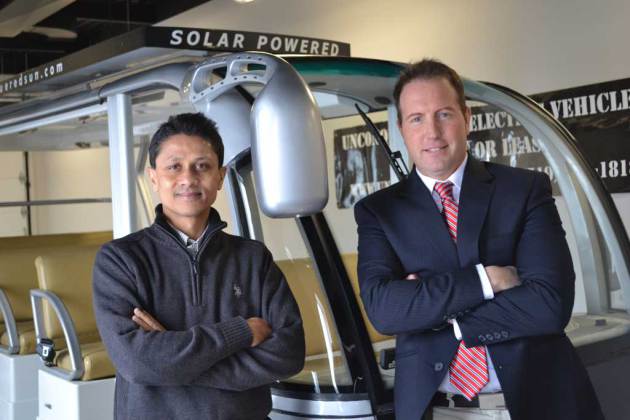
A team of researchers at the University of Windsor and a local solar technologies company have collaborated to prove the benefits of solar power in extending the driving range of electric vehicles.
By harnessing the sun’s rays through rooftop panels, Unconquered Sun Solar Technologies founder and CEO Sean Moore says the driving range can be extended an average of 45 per cent further.
“Every second your foot’s not on the accelerator, when that vehicle’s in the sun, it’s charging,” Moore said. “This way, you have a generator … on your roof.
“Obviously if it’s nighttime or if it’s in a garage, you can just plug it in the wall and it recharges that way too.”
Associate professor Narayan Kar led a team of three PhD students, a masters student and a senior undergraduate in studying the vehicle rooftop solar technology. He said months of research and testing — partially funded by a $20,000 federal research grant received almost a year ago — helped them prove the scientific benefits of solar panels and to show the financial benefits.
The University of Windsor Centre for Hybrid Automotive Research and Green Energy (CHARGE) published a report Dec. 11 outlining the team’s findings. They are expected to publish further technical papers next month.
“What’s great about it is it validates the technology,” Moore said. “It really helps us gain traction in the market … all the research validating the extended range and all the different benefits of having a renewable energy generator on the roof of your car.”
Moore’s company focused on esthetic issues of the rooftop panels by using Lexan, a clear plastic material that is lighter in weight than the typical glass panels used for lamination of solar cells, and a thermal process to form the sheets to fit the radius of different vehicles.
“We have developed an app … that (Moore) can take … on his cellphone to his customers and he can demonstrate the benefits of having a solar panel on the rooftop,” Kar said. “If you have a solar panel and it is in the sun most of the time you will see many days of no (electric) charging needed.”
Moore said he’s hoping to launch sales of low-speed electric vehicles — a new Transport Canada classification in North America — with rooftop solar panels early this spring. Low-speed vehicles have an electric drive train, four wheels on the road and they are restricted to a top speed of 50 kilometres.
The cars, trucks and buses are also limited to a gross vehicle weight of approximately 1,300 kilograms.
“Electric vehicles and particularly low-speed vehicles, the market is expected to be $2.6 billion over the next three years,” Moore said. “With solar on the roofs, they cost literally pennies a month to operate.”
He expects initial demand to come from companies with fixed delivery routes and inter-urban commuters.
Part of the attraction is the cost of the vehicles – estimated at $16,000 for a delivery truck or less than $10,000 for a three-seater passenger vehicle.
Kar, who is also Canada Research Chair in Electrified Transportation Systems, said the search is on for more funding for further research.
“This is not the biggest project in terms of money (for his department) but (it is) in terms of passion, dedication and the amount of time we have spent on this,” Kar said. “We really liked this project and we could really see the benefit of it.
“It was very productive from a research output point of view, student training point of view, relationship building point of view,” he said. “Research is never ending … there is always room for improvement. We have done good things but it could be better.”
